Location Regularization-Based POI Recommendation in Location-Based Social Networks
Abstract
:1. Introduction
2. Related Work
2.1. Implicit Feedback-Based Recommendation
2.2. POI Recommendation with Geographical Characteristics
2.3. Other Context Aware POI Recommendation
3. POI Recommendation Criteria
3.1. Problem Statement
3.2. Weighted BPR Criterion for POI Recommendation
3.3. Our Neighborhood Aware Ranking Criteria
3.3.1. Empirical Data Analysis
3.3.2. Exploitation of Neighborhood Characteristics
3.3.3. Bayesian Inference
| Algorithm 1: The learning process of U and V for NBPR | |
| 1 | Input: |
| 2 | The visit frequency matrix R, neighborhood regularization parameter , |
| learning rate , weight factor w, regularization parameters and | |
| 3 | Output: |
| 4 | U, V |
| 5 | conduct initialization to U and V |
| 6 | do |
| 7 | Extract the sample from |
| 8 | |
| 9 | Using Equation (11) to update ; |
| 10 | Using Equation (12) to update ; |
| 11 | Using Equation (13) to update ; |
| 12 | Calculate L(t) (the value of L in t step) according to Equation (10); |
| 13 | while L(t)−L() > tolerate error (not convergence); |
| 14 | U and V; |
3.4. Computational Complexity
4. Experiments
4.1. Datasets
4.2. Evaluation Metrics
4.3. Performance Comparison
4.4. Impact of Parameter
4.5. The Influence of the Recommendation Number
4.6. Convergence Analysis
5. Conclusions and Future Work
Acknowledgments
Author Contributions
Conflicts of Interest
References
- Ye, M.; Yin, P.; Lee, W.C.; Lee, D.L. Exploiting geographical influence for collaborative point-of-interest recommendation. In Proceedings of the 34th international ACM SIGIR Conference on Research and Development in Information Retrieval, Beijing, China, 24–28 July 2011; pp. 325–334. [Google Scholar]
- Cheng, C.; Yang, H.; King, I.; Lyu, M.R. Fused Matrix Factorization with Geographical and Social Influence in Location-Based Social Networks. In Proceedings of the Twenty-Sixth AAAI Conference on Artificial Intelligence, Toronto, ON, Canada, 22–26 July 2012; Volume 12, pp. 17–23. [Google Scholar]
- Zhang, J.D.; Chow, C.Y. iGSLR: personalized geo-social location recommendation: A kernel density estimation approach. In Proceedings of the 21st ACM SIGSPATIAL International Conference on Advances in Geographic Information Systems, Orlando, FL, USA, 5–8 November 2013; pp. 334–343. [Google Scholar]
- Liu, B.; Fu, Y.; Yao, Z.; Xiong, H. Learning geographical preferences for point-of-interest recommendation. In Proceedings of the 19th ACM SIGKDD International Conference on Knowledge Discovery and Data Mining, Chicago, IL, USA, 11–14 August 2013; pp. 1043–1051. [Google Scholar]
- Lian, D.; Zhao, C.; Xie, X.; Sun, G.; Chen, E.; Rui, Y. GeoMF: Joint geographical modeling and matrix factorization for point-of-interest recommendation. In Proceedings of the 20th ACM SIGKDD International Conference on Knowledge Discovery and Data Mining, New York, NY, USA, 24–27 August 2014; pp. 831–840. [Google Scholar]
- Pan, R.; Zhou, Y.; Cao, B.; Liu, N.N.; Lukose, R.; Scholz, M.; Yang, Q. One-class collaborative filtering. In Proceedings of the 2008 Eighth IEEE International Conference on Data Mining, Pisa, Italy, 15–19 December 2008; pp. 502–511. [Google Scholar]
- Li, X.; Cong, G.; Li, X.L.; Pham, T.A.N.; Krishnaswamy, S. Rank-GeoFM: A ranking based geographical factorization method for point of interest recommendation. In Proceedings of the 38th International ACM SIGIR Conference on Research and Development in Information Retrieval, Santiago, Chile, 9–13 August 2015; pp. 433–442. [Google Scholar]
- Ying, H.; Chen, L.; Xiong, Y.; Wu, J. PGRank: Personalized Geographical Ranking for Point-of-Interest Recommendation. In Proceedings of the 25th International Conference Companion on World Wide Web, Montréal, QC, Canada, 11–15 April 2016; pp. 137–138. [Google Scholar]
- Liu, Y.; Wei, W.; Sun, A.; Miao, C. Exploiting geographical neighborhood characteristics for location recommendation. In Proceedings of the 23rd ACM International Conference on Conference on Information and Knowledge Management, Shanghai, China, 3–7 November 2014; pp. 739–748. [Google Scholar]
- Guo, L.; Ma, J.; Jiang, H.R.; Chen, Z.M.; Xing, C.M. Social Trust Aware Item Recommendation for Implicit Feedback. J. Comput. Sci. Technol. 2015, 30, 1039–1053. [Google Scholar] [CrossRef]
- Hu, Y.; Koren, Y.; Volinsky, C. Collaborative filtering for implicit feedback datasets. In Proceedings of the 2008 Eighth IEEE International Conference on Data Mining, Pisa, Italy, 15–19 December 2008; pp. 263–272. [Google Scholar]
- Rendle, S.; Freudenthaler, C.; Gantner, Z.; Schmidt-Thieme, L. BPR: Bayesian personalized ranking from implicit feedback. In Proceedings of the Twenty-Fifth Conference on Uncertainty in Artificial Intelligence, Montreal, QC, Canada, 18–21 June 2009; pp. 452–461. [Google Scholar]
- Yin, H.; Cui, B.; Chen, L.; Hu, Z.; Zhang, C. Modeling location-based user rating profiles for personalized recommendation. ACM Trans. Knowl. Discov. Data (TKDD) 2015, 9, 19. [Google Scholar] [CrossRef]
- Gao, H.; Tang, J.; Liu, H. Personalized location recommendation on location-based social networks. In Proceedings of the 8th ACM Conference on Recommender Systems, Foster City, Silicon Valley, CA, USA, 6–10 October 2014; pp. 399–400. [Google Scholar]
- Zheng, V.W.; Zheng, Y.; Xie, X.; Yang, Q. Towards mobile intelligence: Learning from GPS history data for collaborative recommendation. Artif. Intell. 2012, 184, 17–37. [Google Scholar] [CrossRef]
- Cho, S.B. Exploiting machine learning techniques for location recognition and prediction with smartphone logs. Neurocomputing 2016, 176, 98–106. [Google Scholar] [CrossRef]
- Zhang, J.D.; Chow, C.Y.; Li, Y. iGeoRec: A personalized and efficient geographical location recommendation framework. IEEE Trans. Serv. Comput. 2015, 8, 701–714. [Google Scholar] [CrossRef]
- Guo, L.; Jiang, H.; Wang, X.; Liu, F. Learning to Recommend Point-of-Interest with the Weighted Bayesian Personalized Ranking Method in LBSNs. Information 2017, 8, 20. [Google Scholar] [CrossRef]
- Liu, Y.; Pham, T.A.N.; Cong, G.; Yuan, Q. An experimental evaluation of point-of-interest recommendation in location-based social networks. Proc. VLDB Endow. 2017, 10, 1010–1021. [Google Scholar] [CrossRef]
- Yuan, Q.; Cong, G.; Ma, Z.; Sun, A.; Thalmann, N.M. Time-aware point-of-interest recommendation. In Proceedings of the 36th International ACM SIGIR Conference on Research and Development in Information Retrieval, Dublin, Ireland, 28 July–1 August 2013; pp. 363–372. [Google Scholar]
- Gao, H.; Tang, J.; Hu, X.; Liu, H. Content-Aware Point of Interest Recommendation on Location-Based Social Networks. In Proceedings of the Twenty-Ninth AAAI Conference on Artificial Intelligence, Austin, TX, USA, 25–30 January 2015; pp. 1721–1727. [Google Scholar]
- Griesner, J.B.; Abdessalem, T.; Naacke, H. POI Recommendation: Towards Fused Matrix Factorization with Geographical and Temporal Influences. In Proceedings of the 9th ACM Conference on Recommender Systems, Vienna, Austria, 16–20 September 2015; pp. 301–304. [Google Scholar]
- Li, H.; Ge, Y.; Hong, R.; Zhu, H. Point-of-Interest Recommendations: Learning Potential Check-ins from Friends. In Proceedings of the 22nd ACM SIGKDD International Conference on Knowledge Discovery and Data Mining, San Francisco, CA, USA, 13–17 August 2016; pp. 975–984. [Google Scholar]
- Gao, H.; Tang, J.; Hu, X.; Liu, H. Exploring temporal effects for location recommendation on location-based social networks. In Proceedings of the 7th ACM Conference on Recommender Systems, Hong Kong, China, 12–16 October 2013; pp. 93–100. [Google Scholar]
- Tsiropoulou, E.E.; Thanou, A.; Paruchuri, S.T.; Papavassiliou, S. Self-organizing museum visitor communities: A participatory action research based approach. In Proceedings of the 2017 12th International Workshop on Semantic and Social Media Adaptation and Personalization (SMAP), Bratislava, Slovakia, 9–10 July 2017; pp. 101–105. [Google Scholar]
- Tsiropoulou, E.E.; Thanou, A.; Papavassiliou, S. Modelling museum visitors’ Quality of Experience. In Proceedings of the 2016 11th International Workshop on Semantic and Social Media Adaptation and Personalization (SMAP), Thessaloniki, Greece, 20–21 October 2016; pp. 77–82. [Google Scholar]
- Tsiropoulou, E.E.; Thanou, A.; Papavassiliou, S. Quality of Experience-based museum touring: A human in the loop approach. Soc. Netw. Anal. Min. 2017, 7, 33. [Google Scholar] [CrossRef]
- De Rojas, C.; Camarero, C. Visitors’ experience, mood and satisfaction in a heritage context: Evidence from an interpretation center. Tour. Manag. 2008, 29, 525–537. [Google Scholar] [CrossRef]
- Breese, J.S.; Heckerman, D.; Kadie, C. Empirical analysis of predictive algorithms for collaborative filtering. In Proceedings of the Fourteenth Conference on Uncertainty in Artificial Intelligence, Madison, WI, USA, 24–26 July 1998; pp. 43–52. [Google Scholar]
- Jamali, M.; Ester, M. A matrix factorization technique with trust propagation for recommendation in social networks. In Proceedings of the 4th ACM Conference on Recommender Systems, Barcelona, Spain, 26–30 September 2010; pp. 135–142. [Google Scholar]
- Cho, E.; Myers, S.A.; Leskovec, J. Friendship and mobility: User movement in location-based social networks. In Proceedings of the 17th ACM SIGKDD International Conference on Knowledge Discovery and Data Mining, San Diego, CA, USA, 21–24 August 2011; pp. 1082–1090. [Google Scholar]

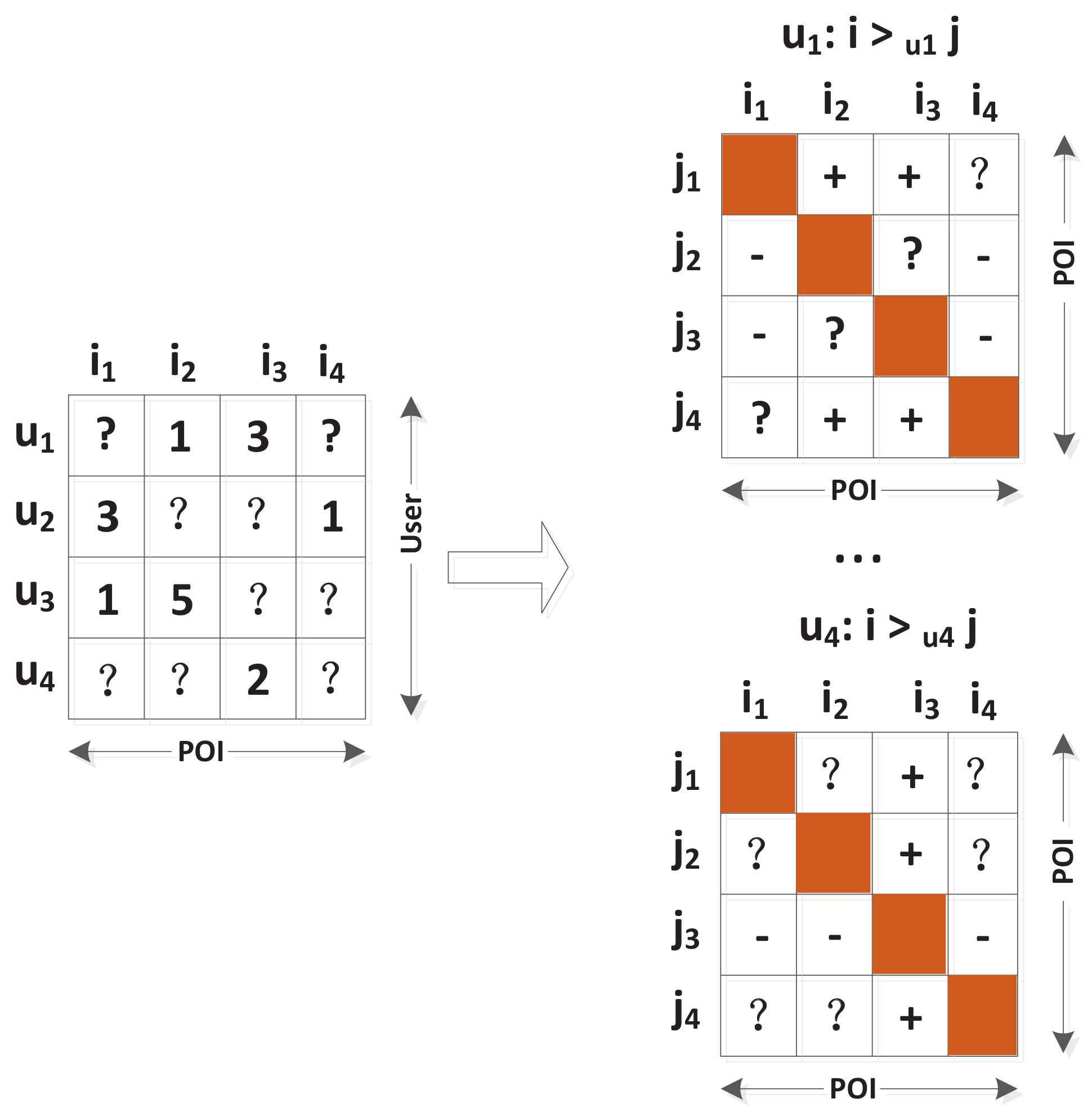
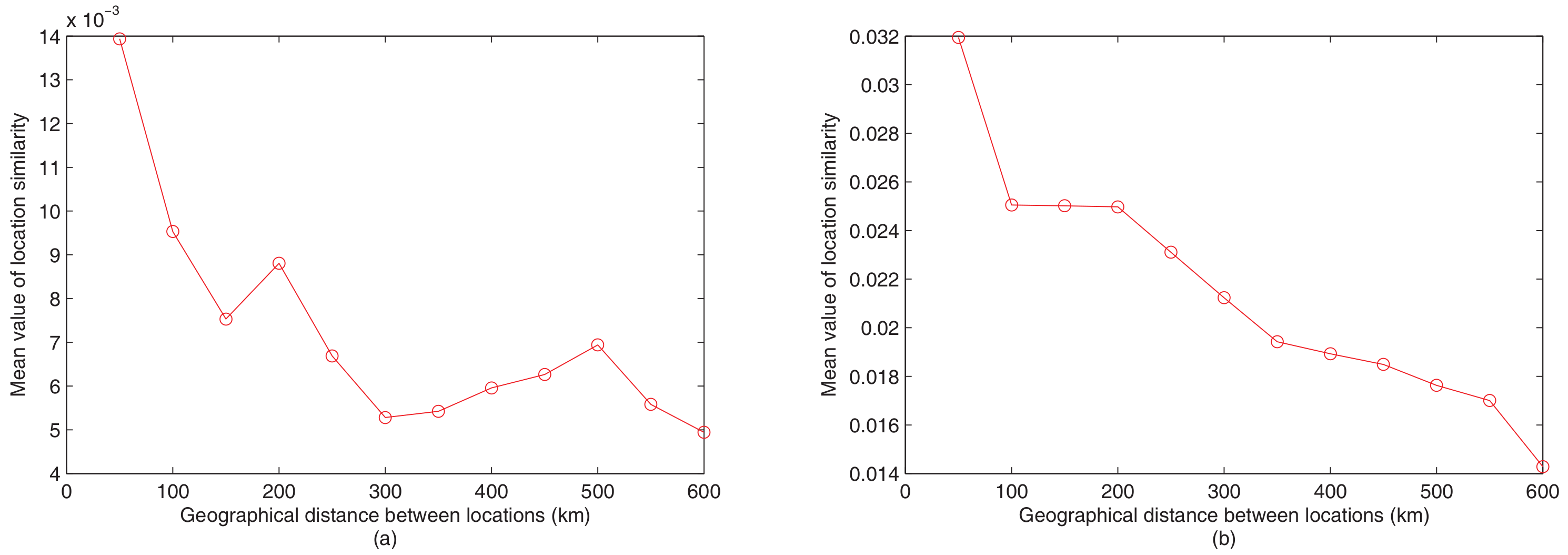
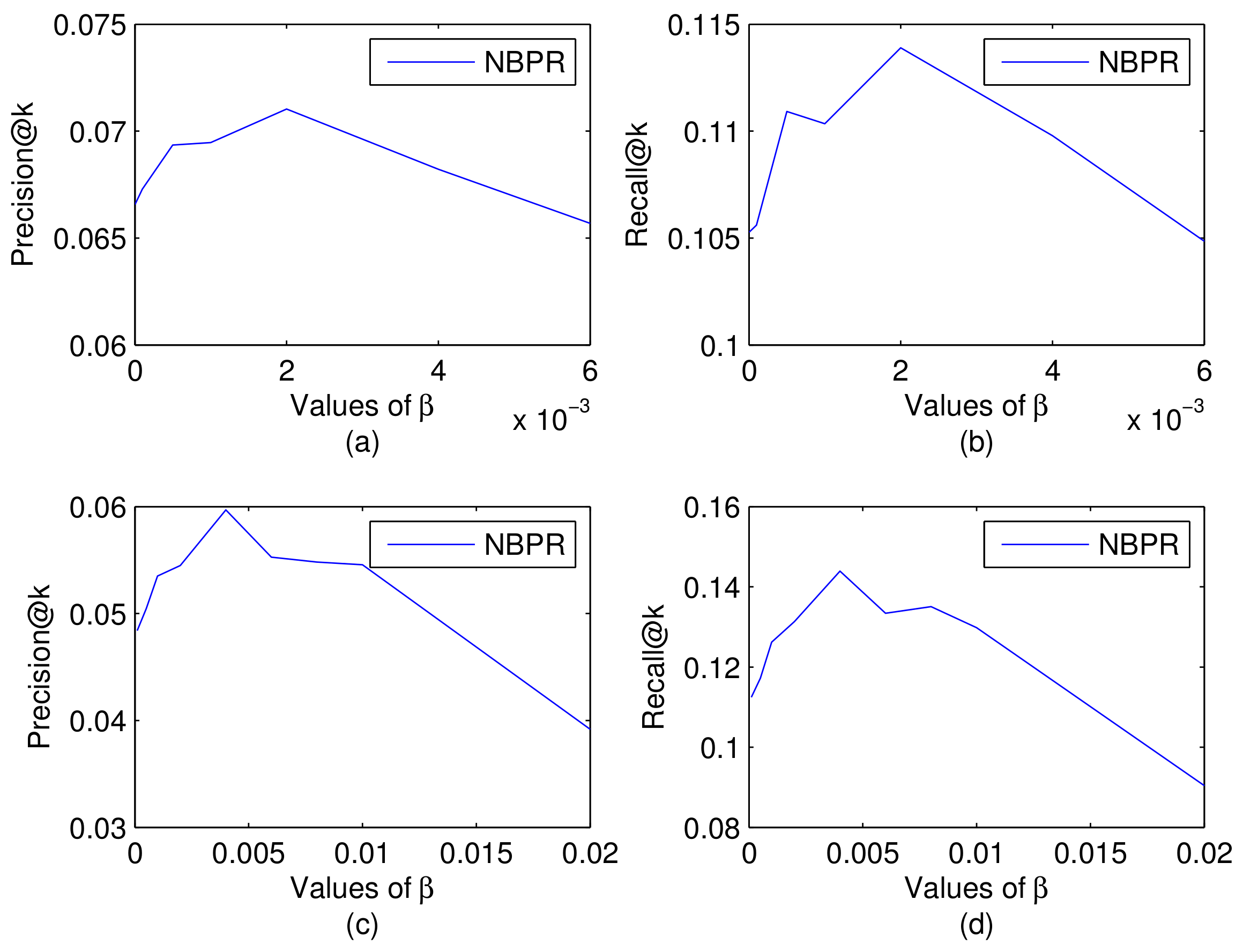
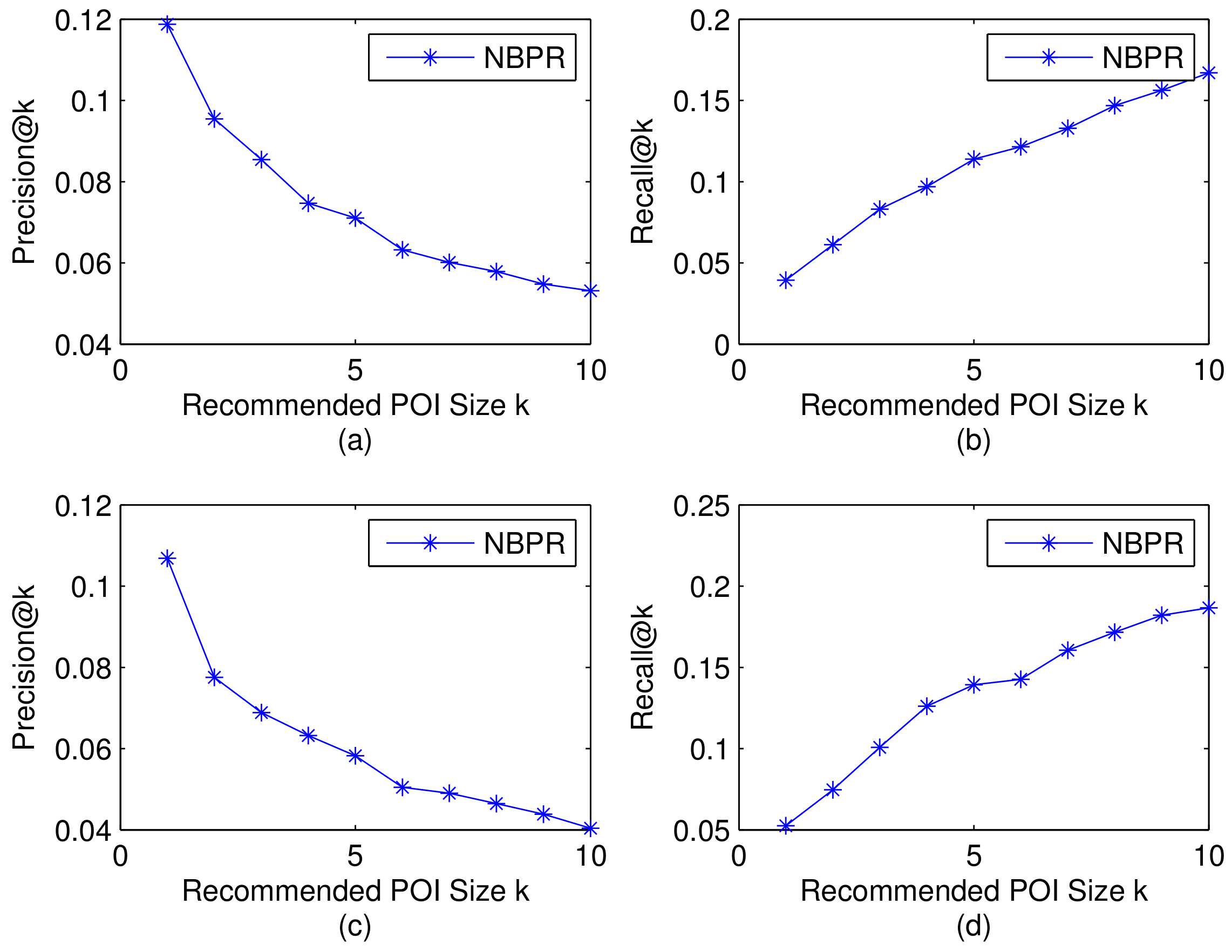
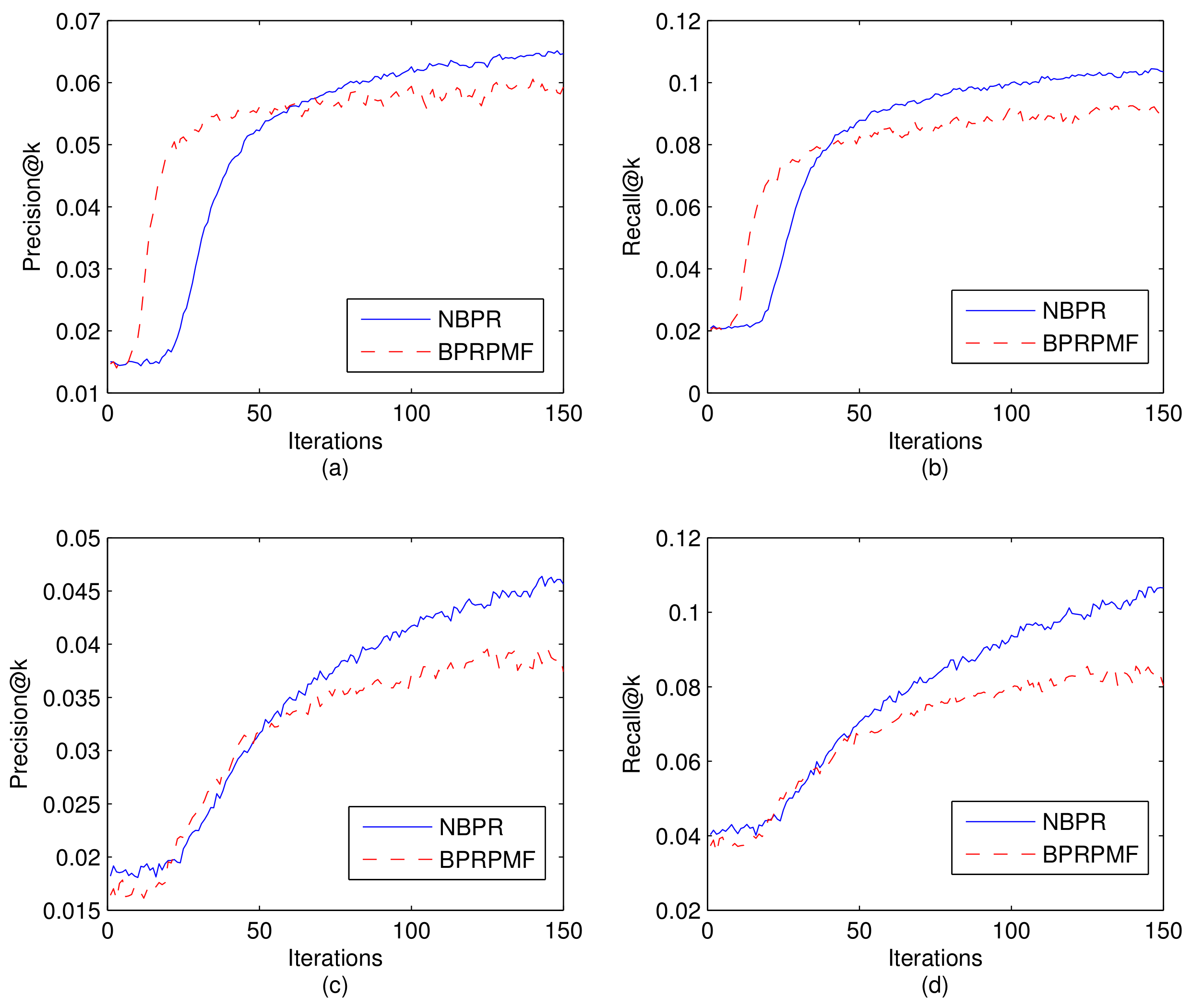
| Notations | Meaning |
|---|---|
| the check-in matrix and the reconstructed check-in data, respectively | |
| the check-in frequency of user u over POI i | |
| the relationship between user u, POI i and POI j | |
| a personalized total ranking of all POI pairs to user u | |
| the user and POI set, respectively | |
| a personalized total ranking of all POI pairs to user u | |
| user u prefers POI i than j | |
| the parameter of any model class | |
| the latent feature factors of users and POIs, respectively | |
| the column vector of U and V, respectively | |
| the estimated feature vector of POI v | |
| the weight factor of the relationship between and j | |
| the regularization parameters of , respectively | |
| the regularization parameter of relationship between V and its neighbors | |
| the regularization parameter that equals | |
| the user set that has visited POI i in the past | |
| the POI neighborhood relation graph | |
| the geographical neighborhood relation | |
| S | the adjacency matrix of graph |
| the geographical distance between POI v and t | |
| the row normalization form of matrix S | |
| the set of K nearest POIs of POI v, where K is an integer | |
| the POI set visited by user u in the test data | |
| the top-k POI set that recommended to user u, where k is the size of the recommendation list |
| Statistics | Gowalla | Brightkite |
|---|---|---|
| Check-in sparsity | 99.838 | 99.833 |
| # of users | 32,134 | 11,142 |
| # of POIs | 8867 | 4369 |
| # of check-ins | 575,323 | 100,069 |
| Min. # of check-ins per POI | 1 | 1 |
| Min. # of POIs per user | 5 | 3 |
| Metric | Dataset | MostPopular | WRMF | GeoMF | BPRMF | IRenMF | WBPR-F | NBPR |
|---|---|---|---|---|---|---|---|---|
| Gowalla | ||||||||
| Brightkite | ||||||||
| Gowalla | ||||||||
| Brightkite |
© 2018 by the authors. Licensee MDPI, Basel, Switzerland. This article is an open access article distributed under the terms and conditions of the Creative Commons Attribution (CC BY) license (http://creativecommons.org/licenses/by/4.0/).
Share and Cite
Guo, L.; Jiang, H.; Wang, X. Location Regularization-Based POI Recommendation in Location-Based Social Networks. Information 2018, 9, 85. https://doi.org/10.3390/info9040085
Guo L, Jiang H, Wang X. Location Regularization-Based POI Recommendation in Location-Based Social Networks. Information. 2018; 9(4):85. https://doi.org/10.3390/info9040085
Chicago/Turabian StyleGuo, Lei, Haoran Jiang, and Xinhua Wang. 2018. "Location Regularization-Based POI Recommendation in Location-Based Social Networks" Information 9, no. 4: 85. https://doi.org/10.3390/info9040085





